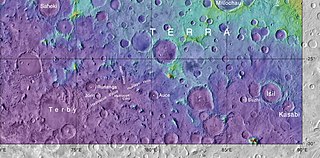Related Research Articles

The International Phonetic Alphabet (IPA) is an alphabetic system of phonetic notation based primarily on the Latin script. It was devised by the International Phonetic Association in the late 19th century as a standardized representation of speech sounds in written form. The IPA is used by lexicographers, foreign language students and teachers, linguists, speech–language pathologists, singers, actors, constructed language creators, and translators.
The Nyabwa language is a Kru language spoken in Ivory Coast. It is part of the Wee dialect continuum.
Ò, ò (o-grave) is a letter of the Latin script.

The Mandinka language or Mandingo, is a Mande language spoken by the Mandinka people of Guinea, northern Guinea-Bissau, the Casamance region of Senegal, and in The Gambia where it is one of the principal languages.

Southern Bantoid is a branch of the Bantoid language family. It consists of the Bantu languages along with several small branches and isolates of eastern Nigeria and west-central Cameroon. Since the Bantu languages are spoken across most of Sub-Saharan Africa, Southern Bantoid comprises 643 languages as counted by Ethnologue, though many of these are mutually intelligible.

In typesetting, the hook above is a diacritic mark placed on top of vowels in the Vietnamese alphabet. In shape it looks like a tiny question mark without the dot underneath, or a tiny glottal stop (ʔ). For example, a capital A with a hook is "Ả", and a lower case "u" with a hook is "ủ". The hook is usually written to the right of the circumflex in conventional Vietnamese orthography. If Vietnamese characters are unavailable, it is often replaced by a question mark after the vowel.
Sidney Lau romanisation is a system of romanisation for Cantonese that was developed in the 1970s by Sidney Lau for teaching Cantonese to Hong Kong Government expatriates. It is based on the Hong Kong Government's Standard Romanisation which was the result of the work of James D. Ball and Ernst J. Eitel about a century earlier.
The double grave accent is a diacritic used in scholarly discussions of the Serbo-Croatian and sometimes Slovene languages. It is also used in the International Phonetic Alphabet.
Ewondo or Kolo is the language of the Ewondo people of Cameroon. The language had 577,700 native speakers in 1982. Ewondo is a trade language. Dialects include Badjia (Bakjo), Bafeuk, Bamvele, Bane, Beti, Enoah, Evouzok, Fong, Mbida-Bani, Mvete, Mvog-Niengue, Omvang, Yabekolo (Yebekolo), Yabeka, and Yabekanga. Ewondo speakers live primarily in Cameroon's Centre Region and the northern part of the Océan division in the South Region.
Chang-Du or Chang-Jing, sometimes called Nanchang after its principal dialect, is one of the Gan Chinese languages. It is named after Nanchang and Duchang County, and is spoken in those areas as well as in Xinjian, Anyi, Yongxiu, De'an, Xingzi, Hukou, and bordering regions in Jiangxi and in Pingjiang County, Hunan.
The spelling of Gwoyeu Romatzyh (GR) can be divided into its treatment of initials, finals and tones. GR uses contrasting unvoiced/voiced pairs of consonants to represent aspirated and unaspirated initials in Chinese: for example b and p represent IPA [p] and [pʰ]. The letters j, ch and sh represent two different series of initials: the alveolo-palatal and the retroflex sounds. Although these spellings create no ambiguity in practice, readers more familiar with Pinyin should pay particular attention to them: GR ju, for example, corresponds to Pinyin zhu, not ju.
Gokana (Gòkánà) is an Ogoni language spoken by some 130,000 people in Rivers State, Nigeria.
Puguli or Phuie (Pwĩẽ) is the language of the Phuo people. It is spoken in Burkina Faso.
Ogba is an Igboid language spoken by Ogba people of Nigeria.
Tem, or Kotokoli (Cotocoli), is a Gur language spoken in Togo, Ghana, Benin and Burkina Faso. It is used by neighboring peoples. In Ghana the Kotokoli people comes from a northern part of the Volta Region a town called Koue. Koue shares boarder with Togo with a small river which is called the Koue river separating it from Togo.
Nateni (Natemba) is a language of the Gurma people spoken in Benin. It is named after its principal dialect; the others are Tayari (Tayaba), Kunteni (Kuntemba), Okoni (Okoma).

Tammari is a language which is spoken in Benin and Togo. It is also known as Ditammari. The Tammari people, who live in Benin and Togo, mostly speak the language. There are about 47.000 speakers. About half live in Togo, the other half in Benin. Ditammari is one of the Gur languages.
There are two versions of the language, Eastern Ditammari and Western Ditammari. Western Ditamari is also called Tamberma or Taberma.
Manza is a Ubangian language spoken by the Mandja people of the Central African Republic. It is closely related to Ngbaka and may be to some extent mutually intelligible.
Orejón (Oregon), also Coto or Maijiki, is a moribund Tucanoan language of Peru.

Suzhi is an impact crater on Mars, located in the Iapygia quadrangle at 27.7°S and 274.0°W. It measures 24.63 kilometres (15.30 mi) in diameter and was named by the International Astronomical Union (IAU) Working Group for Planetary System Nomenclature in 1991 after a place in China. There may have been a lake in the crater in the past because layers are visible in a depression on the floor.
References
- ↑ Esimbi at Ethnologue (25th ed., 2022)